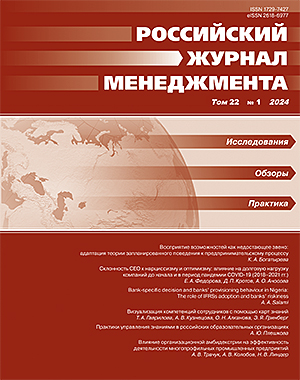Влияние организационной амбидекстрии на эффективность деятельности многопрофильных промышленных предприятий
DOI:
https://doi.org/10.21638/spbu18.2024.106Аннотация
Цель исследования: поиск оптимального набора инструментов, позволяющих многопрофильным промышленным предприятиям достичь организационной амбидекстрии, оцениваемой в двух аспектах совершенствования деятельности — поисковой и операционной. Определение влияния организационной амбидекстрии на эффективность ведения бизнеса многопрофильными промышленными предприятиями.
Методология исследования: выбор оптимального набора инструментов осуществлен с помощью построения регрессионных моделей и методов математической оптимизации. Влияние операционной амбидекстрии на показатели компании установлено с помощью статистических тестов. Эмпирической базой исследования стали 327 реализованных проектов в 16 многопрофильных промышленных предприятиях.
Результаты исследования: разработана модель, позволяющая выбрать оптимальный набор инструментов в целях совершенствования производства и формирования базы для развития новых видов деятельности, т. е. достижения организационной амбидекстрии. Показано, что достижение эффективности поисковой деятельности в наибольшей степени влияет на показатель производительности труда и количество новых компетенций, в то время как совершенствование операционной деятельности — на долю сертифицированной по международным стандартам продукции в общем объеме производства компании и количество новых компетенций у сотрудников организации, направленных на достижение организационной амбидекстрии.
Оригинальность и вклад авторов: исследование определяет условия достижения организационной амбидекстрии многопрофильными промышленными пред приятиями. Предложена новая модель, позволяющая определить оптимальный набор инструментов для совершенствования производства и развития новых видов деятельности, обеспечивающих достижение организационной амбидекстрии и повышение эффективности многопрофильных промышленных предприятий.
Ключевые слова:
многопрофильное промышленное предприятие, промышленность, организационная амбидекстрия, эффективность, совершенствование текущей и поисковой деятельности, адаптивность, производительность
Скачивания
Библиографические ссылки
References in Latin Alphabet
Translation of references in Russian into English
Загрузки
Опубликован
Как цитировать
Выпуск
Раздел
Лицензия
Статьи журнала «Российский журнал менеджмента» находятся в открытом доступе и распространяются в соответствии с условиями Лицензионного Договора с Санкт-Петербургским государственным университетом, который бесплатно предоставляет авторам неограниченное распространение и самостоятельное архивирование.





